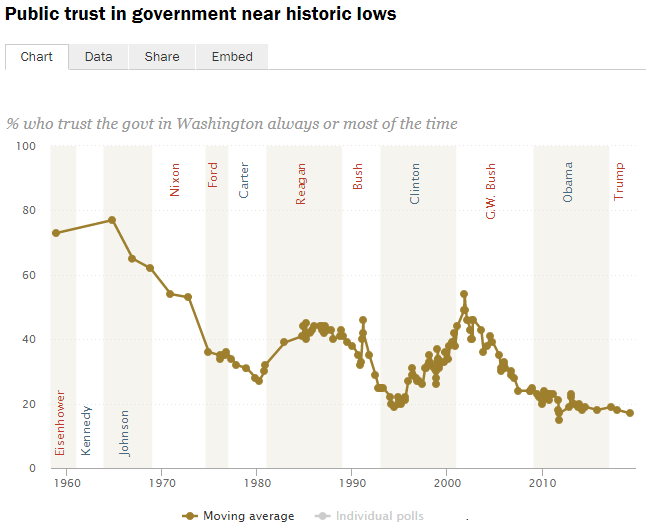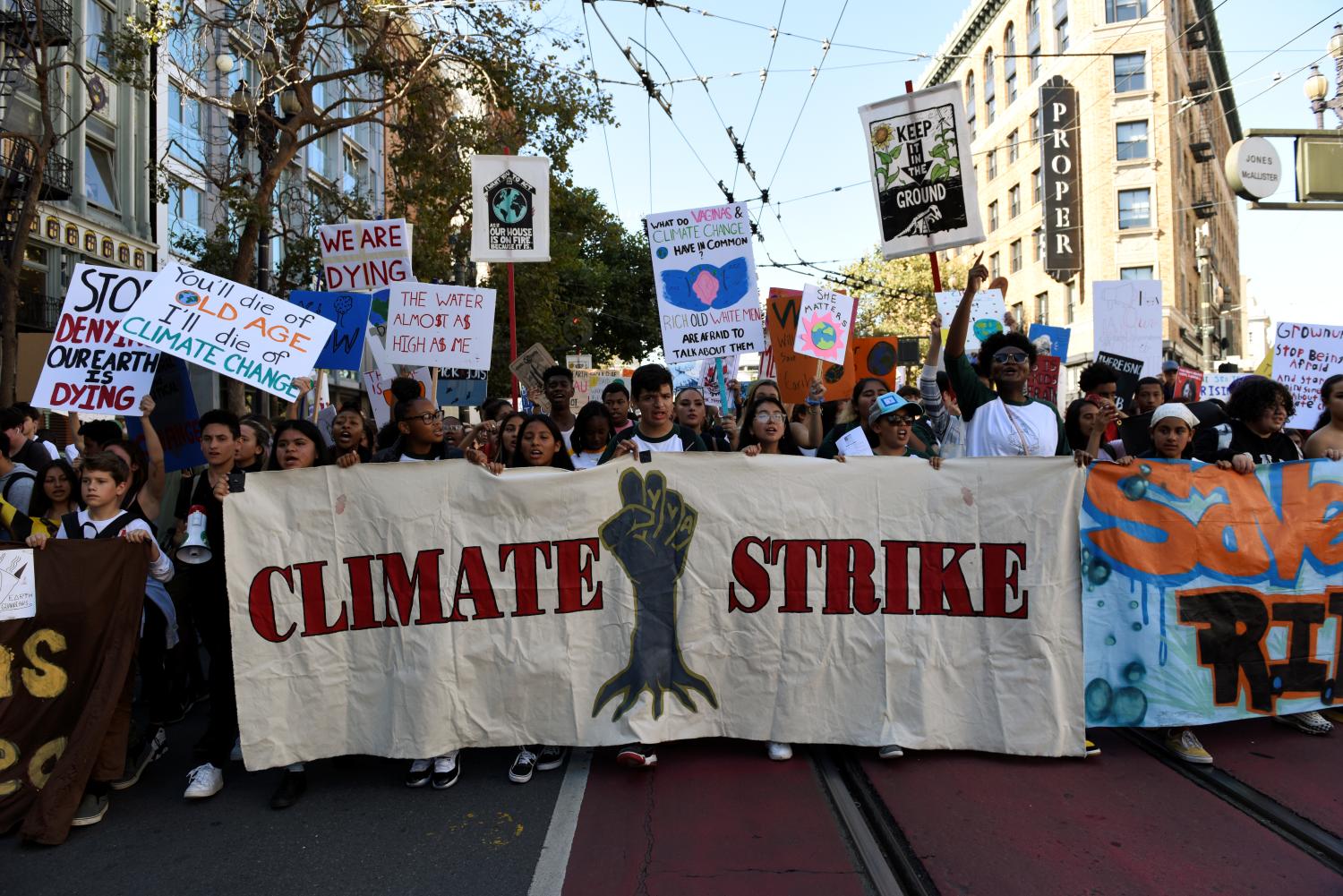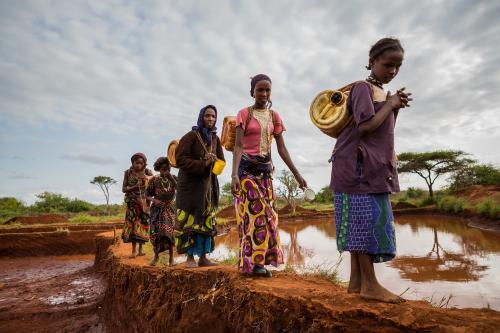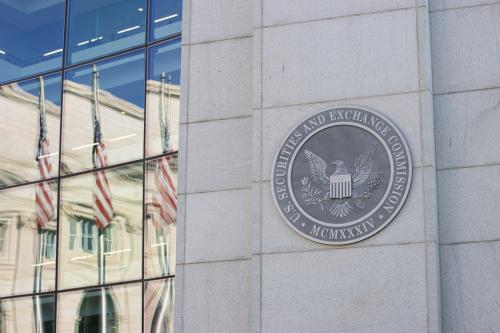“We don’t really worry about climate change because it’s too overwhelming and we’re already in too deep. It’s like if you owe your bookie $1,000, you’re like, ‘OK, I’ve got to pay this dude back.’ But if you owe your bookie $1 million dollars, you’re like, ‘I guess I’m just going to die.’”
— Colin Jost, Saturday Night Live, 10/13/18
The above quote is from a Saturday Night Live skit on the weekend following release of a report from the United Nation’s Intergovernmental Panel on Climate Change. The report was one of the most dramatic ones yet, predicting that some of the most severe social and economic damage from the rise in global temperatures could come as soon at 2040. And yet, two comedians, Colin Jost and Michael Che, summed up the difficult (and perhaps impossible) politics of the issue in less than three minutes. You don’t have to be a climate denier to be, in the end, indifferent to the issue.
As the climate crisis becomes more serious and more obvious, Americans remain resistant to decisive and comprehensive action on climate change. In “The Uninhabitable Earth: Life After Warming,” David Wallace-Wells paints a frightening picture of the coming environmental apocalypse. Whole parts of the globe will become too hot for human habitation and those left behind will die of heat. Diseases will increase and mutate. Food shortages will become chronic as we fail to move agriculture from one climate to another. Whole countries like Bangladesh and parts of other countries like Miami will be underwater. Shortages of fresh water will affect humans and agriculture. The oceans will die, the air will get dirtier. “But,” as Wallace-Wells argues, “what lies between us and extinction is horrifying enough.”1 That’s because, as climate change takes its toll on Earth’s physical planet, it will also cause social, economic, and political chaos as refugees flee areas that can no longer sustain them. If this prediction seems a bit extreme, all we have to do is look at recent weather events that keep breaking records to confront the possibility that the threat from climate change may indeed be existential.
public opinion on the climate crisis
Yet, in spite of the evidence at hand, climate change remains the toughest, most intractable political issue we, as a society, have ever faced. This is not to say that there hasn’t been progress. In the United States, the amount of greenhouse gas emissions has held steady since 1990–even though our economy and our population has grown.2 But globally, greenhouse gases have increased since then, bringing humanity very close to the dangerous levels of global warming that were predicted.3 As scientific evidence about the causes of climate change has mounted and as a consensus has evolved in the scientific community, the public has remained divided and large, important parts of the political class have been indifferent. For instance, although 2017 was a year of 16 different billion-dollar natural disasters,4 according to the National Oceanic and Atmospheric Administration, the percentage of voters who were “very concerned” about climate change stayed within the 40% range–where it has been rather stubbornly stuck for the past two years.5 The following chart shows Gallup public opinion polling for the past two decades.6 During this period, but especially in the most recent decade, about a third to almost half of the public believes that the seriousness of global warming is generally exaggerated.
Dramatic and unprecedented natural disasters have had little effect on the public. Following blizzards and an unusually frigid winter in 2015, only 37% of Americans said climate change would pose a serious threat to them in their lifetimes.7 After Hurricane Harvey and Hurricane Irma in 2017, concern about climate change increased by 7 points among Republicans and 2 points among Democrats.8 But in the next year, an August 2018 poll taken shortly after the California wildfires showed concern among Republicans down to 44% and up to 79% among Democrats.9 In a YouGov poll in the summer of 2019—during record heat waves in the U.S. and Europe—only 42% of the public said that they were very concerned and only 22% of Republicans said that they were” very concerned about climate change.”10
If natural disasters don’t affect attitudes toward climate change, partisanship does. The following chart from Pew Research shows the gulf that exists between Democrats and Republicans on this issue.11

The partisan divide began in the late 1990s and has increased over time. In 1997, nearly equal numbers of Democrats and Republicans said that the effects of global warming have already begun. Ten years later, the gap was 34%: 76% of Democrats said the effects had already begun, and only 42% of Republicans agreed.
Republican resistance on this issue is one but not the only reason why, in the face of mounting evidence, the public remains lukewarm on this existential issue. The dire warnings, the scientific consensus, and the death toll from unprecedented climate events have failed to move the public very much. For two years now, the number of Americans who say they are “very concerned” about climate change fails to reach 50%, as a look at polling from Quinnipiac illustrates.12
An even more telling piece of evidence on public indifference to climate change comes from 30 years of open-ended polling conducted by Gallup. Open-ended polling is especially interesting since it elicits an unprompted response from the individual. Between 1989 and 2019, Gallup has asked “What do you think is the most important problem facing this country today?” Jobs, the economy, and health care are often at the top of the list. “Environment/pollution” is not often mentioned. In fact, over a 30-year period, it was mentioned by anywhere from less than 0.5% to 8% of the public. In the most recent 2019 poll (August), “the government/poor leadership” was mentioned by 22% of the public, and “immigration” by 18%. “Environment/pollution/climate change” garnered only 3% of the public. And in some earlier polls, climate change is not even mentioned by a significant portion of the public (although people could be including that within the term environment.)13
Why can’t we get our heads around this?
Given the severity of the climate crisis and the potential for existential damage to the human race and planet, the lack of intensity around the issue is simultaneously incomprehensible and totally understandable. So let’s look at the latter. The explanations fall into at least four categories: complexity; jurisdiction and accountability; collective action and trust; and imagination.
Complexity
Complexity is the death knell of many modern public policy problems and solutions. And complexity is inherent in climate change. The causes of global warming are varied, including carbon dioxide, methane, and nitrous oxide. As the climate warms, it affects glaciers, sea levels, water supply, rainfall, evaporation, wind, and a host of other natural phenomenon that affect weather patterns. Unlike an earlier generation of environmental problems, it is hard to see the connections between coal plants in one part of the world and hurricanes in another. In contrast, when the water in your river smells and turns a disgusting color and dead fish float on top of it, no sophisticated scientific training is required to understand the link between what’s happening in the river and the chemical plant dumping things into it. The first generation of the environmental movement had an easier time making the connection between cause and effect.
Evidence for this comes from approximately three decades of polling on the environment by Gallup. In the chart below, most of the polls took place between 1989 and 2019.14 Note that, over time, the most worrisome environmental problems are visible pollution problems. Water, soil, and ocean and beach pollution are at the top. These are things average people can see and smell. Global warming or climate change is toward the bottom. These numbers change somewhat over time and understandably so, which is why data is included from 2019 where available. People are more worried about climate change than they used to be. Nonetheless, the complexity of the issue compared to the more straightforward cause-and-effect characteristics of other environmental issues is a major impediment to political action.
| Environmental issue | Range of the public who worried about this “a great deal” (from ~1989 to ~2019) | Median percentage | Public who worried about this “a great deal” in 2019 |
| Pollution of drinking water | 48% to 72% | 57.50% | 56% |
| Pollution of rivers, lakes and reservoirs | 46% to 72% | 53% | 53% |
| Contamination of soil and water by toxic waste | 44% to 69% | 52% | – |
| Ocean and beach pollution | 43% to 60% | 52% | – |
| Loss of natural habitat for wildlife | 44% to 58% | 51% | – |
| Air pollution | 36% to 63% | 45% | 43% |
| Damage to Earth’s ozone layer | 33% to 51% | 43% | – |
| Loss of tropical rain forests | 33% to 51% | 40% | 39% |
| Extinction of plant and animal species | 31% to 46% | 37% | 43% |
| Global warming or climate change | 24% to 45% | 34% | 44% |
| Urban sprawl and loss of open spaces | 26% to 42% | 33% | – |
| Acid rain | 20% to 41% | 26.50% | – |
| Source: Gallup. | |||
When former Vice President Al Gore was awarded the Nobel Peace Prize in 2007, along with the Intergovernmental Panel on Climate Change, the prize was for “their efforts to build up and disseminate greater knowledge about man-made climate change.” Through his books, his famous slide show, and his 2006 movie, “An Inconvenient Truth,” Gore made it his mission to explain the scientific processes that make global warming so dangerous. But the inherent complexity of cause and effect in climate change makes it a topic in need of continuous education.
Jurisdiction and accountability
The second major impediment to political action stems from problems of jurisdiction and accountability. From the beginning, modern government has relied upon the concept of jurisdiction–“territory within which a court or government agency may properly exercise its power.”15 And implicit in the concept of jurisdiction is geography. But two of the stickiest problems of the 21st century–climate change and cybersecurity–are challenging because it is so difficult to nail down jurisdiction. When we are able to establish jurisdiction we are able to establish rules, laws, and accountability for adherence to the law–the three bedrock principles of modern democratic governance. In the absence of jurisdiction, everyone is accountable and therefore no one is accountable.
When a cybercrime or cyberattack occurs, we have trouble with jurisdiction. If the perpetrator of a cyberattack on an electrical grid is a Russian living in Tirana, Albania, who routes attacks through France and Canada, who can prosecute the individual? (Assuming, that is, that we can even find them.) Similarly, if coal plants in China and cattle ranching in Australia increase their outputs of greenhouse gases in one year and there are droughts in Africa and floods in Europe the next, who is responsible?
We currently attribute greenhouse gas emissions to individual countries under the United Nations Framework Convention on Climate Change, and we attribute greenhouse gases to their sources within the United States via the Environmental Protections Agency’s Greenhouse Gas Reporting Program. But attribution without enforcement mechanisms is only half the battle–if that. Nationally and internationally there is no legal architecture that allows us to reward and/or punish those who decrease or increase their greenhouse gas emissions. Even the Paris Agreement–which President Trump pulled the U.S. out of–is only a set of pledges from individual countries. Measurement is a first step toward accountability, and measurement needs constant improvement. But measurement in the absence of accountability is meaningless, especially in situations where many people are skeptical of cause and effect.
The Toxic Release Inventory was established by Congress in 1982 as an amendment to the Superfund Bill. Over the years, the steady flow of information about the release of hazardous chemicals into the environment has had many positive effects on regulators, environmentalists, and industrialists.16 Studies have shown that “facilities reduce emissions by an additional 4.28% on average, and their use of source reduction increases by 3.07% on average when the relative assessed hazard level of a chemical increases compared to when it decreases.”17
But the Toxic Release Inventory has one advantage that the Greenhouse Gas Reporting Program does not. The effects of dangerous chemicals on a population are generally fairly clear and obvious: dirty water, dirty air, difficulty breathing, unusual rates of cancer, etc. The cause and effect is often undeniable as the many lawyers who have represented communities and won their cases against large polluters can attest. Greenhouse gas emissions affect people thousands of miles away from their source and make it easier to believe that it wasn’t the fossil fuels at all, just the weather pattern or an act of God. Hence, the linkage between jurisdiction and accountability is weak.
Collective action and trust
Our increasingly hot summers drive the demand for air conditioning. However, air conditioning adds to the heat outside. Scientists estimate that under a realistic set of circumstances, “waste heat from air conditioners exacerbated the heat island effect, the phenomenon in which densely packed cities experience higher temperatures than similarly situated rural areas.”18 Air conditioning could add as much as 1 degree Celsius (nearly 2 degrees Fahrenheit) to the heat of a city. Which one of us, however, would voluntarily turn off their air conditioning knowing full well that hundreds of thousands of other “free riders” would not?
“It is the lack of trust in government that may be one of the foundational barriers to effective environmental action.”
This is just one simplified version of the collective action problem. People may understand that they should act in a certain way for the greater good, but as individuals, they are loathe to turn off their air conditioning or stop flying places for vacations—knowing that others will not be joining them. This is why government is the most frequent solution to collective action problems. Combating climate change requires collective action on many fronts, and it requires collective action both nationally and internationally. But this is extremely difficult in democracies like the U.S., which face strong individualist traditions in the culture along with a lack of trust in government.
In fact, it is the lack of trust in government that may be one of the foundational barriers to effective environmental action. Writing in the journal Global Environmental Change, E. Keith Smith and Adam Mayer looked at 35 different countries. They found that a lack of trust in institutions blunts the public’s risk perceptions and therefore their willingness to support behaviors or policies to address climate change.19
Their findings make intuitive sense especially in the American context. If you are skeptical about government in general, you are skeptical about your government telling you that you need to do something about climate change; you are even more skeptical about an international body like the United Nations telling you that climate change is a very serious problem. Below is a graph showing the moving average over time of Americans who say they can trust the government in Washington to do what is right “just about always” or “most of the time.”20

Imagination
The final piece to the puzzle of why the political salience of climate change seems so out of step with the physical proof and urgency of the issue may have to do with the realm of imagination. As every journalist knows, it is important to be able to tell a story, and as every teacher knows, we learn best through stories. And novelists and screenwriters are the most effective and powerful storytellers we have in society. And yet, in an intriguing book called “The Great Derangement: Climate Change and the Unthinkable,” the Indian novelist Amitav Ghosh writes that climate change is even more absent in the world of fiction than it is in nonfiction.
To see that this is so, we need only glance through the pages of a few highly regarded literary journals and book reviews, for example, the London Review of books, the New York Review of Books, the Los Angeles Review of Books, the Literary Journal, and the New York Times Review of Books. When the subject of climate change occurs in these publications, it is almost always in relation to nonfiction; novels and short stories are very rarely to be glimpsed within this horizon. Indeed, it could even be said that fiction that deals with climate change is almost by definition not of the kind that is taken seriously by serious literary journals: the mere mention of the subject is often enough to relegate a noel or short story to the genre of science fiction.21
The absence of climate change from novels means that it is also absent from movies and television–the great powerful purveyors of stories in our time. One can’t underestimate the power of fiction in shaping society’s attitudes. Some older Americans can remember how the 1958 novel “Exodus,” by Leon Uris, and the subsequent 1960 movie by the same name impacted a generation of non-Jewish Americans to be supportive of Israel. Or how the 2000 movie “Erin Brockovich,” based on a true story of a young woman who takes on an energy corporation, helped popularize the environmental justice movement.
Ghosh’s contribution to our understanding of this issue is not so much in his sections on politics as it is on his insight that fiction in our age is unable to deal with events that are so improbable and so removed from the agency of the individual that they cannot be written about in any realistic way.
All of which brings us back to our two Saturday Night Live comedians.
Conclusion
We have trouble imagining the potential devastation of climate change. We have trouble trusting governments to lead us into much needed collective action. We have trouble defining the links between jurisdiction and accountability. And we have trouble understanding the causality in the first place.
How can we fix this? And can we fix this in time to avoid the most severe consequences of climate change?
Some people, recognizing the political problem, hope for a technological fix such as carbon capture or some other geoengineering fix. The problem with technological fixes is that they are remote and may very well not be effective in time to stave off massive amounts of social and economic disruption. On the other hand, early-1950s America faced what seemed to be an endlessly heartbreaking polio epidemic; in less than a decade, however, a vaccine was developed and the epidemic ended. Given the technological miracles seen in our lifetime, we should not dismiss a technological solution, and we should invest heavily in one with both public and private dollars.
A second imperative is to increase basic scientific literacy so that the burden of pedagogy does not fall on folks like Al Gore alone. Some of this is already happening with the attention given to STEM training in education. But it is clear that climate change is only one of many complex scientific issues that average citizens will be called upon to understand and act on in the future. A renewed focus on scientific literacy may need to be implemented throughout America’s schools.
Which brings us to the storytellers. Just as Al Gore won an Emmy for a movie on climate change, the creative elements in our society need to help explain what’s at stake. They will find a receptive audience in the younger generation. As evidenced by their activism on this issue—this past week, millions marched in countries around the world to protest inaction around climate change—young people are especially concerned with the environment.22 The millennial generation is a very large one, and they have so far shown themselves to be civic minded and environmentally engaged.
“Awareness without the ability to hold corporations, countries, and individuals accountable will not result in major action on environmental issues. But measurement and accountability without an understanding of the connections between a warmer planet and dangerous climate changes will not result in major action either.”
A third imperative is to strengthen the link between jurisdiction and accountability. Nationally and internationally, we need to be able to reward and punish private and public actors for their environmental actions. The condemnation of Brazil’s government for deforestation and fires in the Amazon was largely without consequences. Until there are penalties for things like greenhouse gas emissions, they will not be reduced in sufficient amounts.
Because this issue poses the ultimate collective action problem, it requires governmental action, such as treaties, taxes, and regulations, for starters. But very few citizens in our country are going to support governmental action without first trusting government to get it right. We need to restore trust in government. It has been on a steady downward slide since the George W. Bush administration. Unless we restore trust in government, we are not likely to achieve significant collective action.
Of course, all these things must proceed hand in hand. Awareness without the ability to hold corporations, countries, and individuals accountable will not result in major action on environmental issues. But measurement and accountability without an understanding of the connections between a warmer planet and dangerous climate changes will not result in major action either. Above all, we need to restore—through government and other means—our trust in collective action.
-
Footnotes
- David Wallace-Wells. “The Uninhabitable Earth: Life After Warming.” Tim Duggan Books. p. 34.
- ”Inventory of U.S. Greenhouse Gas Emissions and Sinks.” U.S. Environmental Protection Agency. Accessed at: https://www.epa.gov/ghgemissions/inventory-us-greenhouse-gas-emissions-and-sinks.
- ”Global greenhouse gas emissions, per type of gas and source, including LULUCF.” Netherlands Environmental Assessment Agency. Accessed at: https://www.pbl.nl/en/infographic/global-greenhouse-gas-emissions-per-type-of-gas-and-source-including-lulucf.
- Adam B. Smith. “2017 U.S. billion-dollar weather and climate disasters: a historic year in context.” Climate.gov. Accessed at: https://www.climate.gov/news-features/blogs/beyond-data/2017-us-billion-dollar-weather-and-climate-disasters-historic-year#targetText=During%202017%2C%20the%20U.S.%20experienced,crop%20freeze%2C%20drought%20and%20wildfire.
- ”U.S. Voters Say No Wall And Don’t Shut Down Government, Quinnipiac University National Poll Finds; Focus On Issues, Not Impeachment, Voters Tell Dems 7-1.” Quinnipiac Poll. Dec. 18, 2018. Accessed at: https://poll.qu.edu/national/release-detail?ReleaseID=2590.
- ”Environment.” Gallup. Accessed at: https://news.gallup.com/poll/1615/environment.aspx.
- Lydia Saad. “U.S. Views on Climate Change Stable After Extreme Winter.” Gallup. March 25, 2015. Accessed at: https://news.gallup.com/poll/182150/views-climate-change-stable-extreme-winter.aspx.
- Jacqueline Toth. “As Wildfires Rage, Divide Widens Between Democratic, GOP Voters on Climate Change.” Morning Consult. Aug. 22, 2018. Accessed at: https://morningconsult.com/2018/08/22/as-wildfires-rage-divide-widens-between-democratic-gop-voters-climate-change/.
- Ibid.
- The Economist/YouGov Poll. July 27-30, 2019. Accessed at: https://d25d2506sfb94s.cloudfront.net/cumulus_uploads/document/hash0nbry8/econTabReport.pdf.
- Brian Kennedy and Meg Hefferon. “U.S. concern about climate change is rising, but mainly among Democrats.” Pew Research Center. Aug. 28, 2019. Accessed at: https://www.pewresearch.org/fact-tank/2019/08/28/u-s-concern-about-climate-change-is-rising-but-mainly-among-democrats/.
- Ibid 5.
- The Roper Center, Cornell University. Accessed at: https://ropercenter.cornell.edu/CFIDE/cf/action/ipoll/ipollResult.cfm?keyword=most+important+problem&keywordoptions=1&exclude=&excludeoptions=1&topic=Any&organization=Gallup&label=&fromdate=1%2F1%2F1980&todate=12%2F31%2F2019&studyId=&questionViewId=&resultsCurrentPage=1&paging=true&historyID=&keywordDisplay=&queryId=317679189933&sortBy=BEG_DATE_DESC&perPage=20
- Ibid 6.
- ”Jurisdiction.” The Legal Information Institute, Cornell Law School. Accessed at: https://www.law.cornell.edu/wex/jurisdiction.
- See Chapter 6 in James Hamilton, “Regulation through Revelation: The Origins, Politics and Impact of the Toxic Release Inventory Program” (Cambridge University Press, 2005) for a history of the many impacts the TRI has had.
- Wayne Fu, Basak Kalkanci, and Ravi Subramanian. “Are Hazardous Substance Rankings Effective? An Empirical Investigation of Information Dissemination about the Relative Hazards of Chemicals and Emissions Reductions.” Manufacturing and Service Operations Management. May 17, 2018.
- Sydney Brownstone. “Whoops: Air Conditioning Is Making Cities Hotter, Not Colder.” Fast Company. June 11, 2014. Accessed at: https://www.fastcompany.com/3031696/whoops-air-conditioning-is-making-cities-hotter-not-colder.
- E. Keith Smith and Adam Mayer. “A social trap for the climate? Collective action, trust and climate change risk perception in 35 countries.” Global Environmental Change, Volume 49, p. 140-153. March 2018.
- ”Public Trust in Government: 1958-2019.” Pew Research Center. Accessed at: https://www.people-press.org/2019/04/11/public-trust-in-government-1958-2019/.
- Amitav Ghosh. “The Great Derangement: Climate Change and the Unthinkable.” University of Chicago Press, p. 7.
- Sandra Laville and Jonathan Watts. “Across the globe, millions join biggest climate protest ever.” The Guardian. Sept. 21, 2019. Accessed at: https://www.theguardian.com/environment/2019/sep/21/across-the-globe-millions-join-biggest-climate-protest-ever




